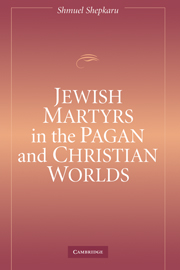Book contents
- Frontmatter
- Contents
- Preface
- Introduction
- 1 Mythic Martyrs
- 2 Between God and Caesar
- 3 “It Is Written in the Law”
- 4 Byzantine Burnt Offerings
- 5 Zarfat
- 6 Ve Ashkenaz: Traditional Manifestations
- 7 Ve Ashkenaz: Manifestations of a Milieu
- 8 Singing in the Fire
- 9 Fire from Heaven
- 10 Shifting Paradigms
- Notes
- Bibliography
- Index
5 - Zarfat
Published online by Cambridge University Press: 17 July 2009
- Frontmatter
- Contents
- Preface
- Introduction
- 1 Mythic Martyrs
- 2 Between God and Caesar
- 3 “It Is Written in the Law”
- 4 Byzantine Burnt Offerings
- 5 Zarfat
- 6 Ve Ashkenaz: Traditional Manifestations
- 7 Ve Ashkenaz: Manifestations of a Milieu
- 8 Singing in the Fire
- 9 Fire from Heaven
- 10 Shifting Paradigms
- Notes
- Bibliography
- Index
Summary
“For out of Bari shall go forth the law, and the word of the Lord from Otranto.” This phraseology of Isaiah 2:3 (“for out of Zion shall go forth the law, and the word of the Lord from Jerusalem”) by the French Tosafist, R. Jacob ben Meir (or Rabbenu Tam), epitomizes the formidable influence Byzantine-Italian Jewry had on the Jews of Latin Europe. Jacob's comparison bestows on these Italian communities almost a divine authority. It is only logical to presume that Bari's “law” and Otranto's “word” included also their martyrological views and literature. Put differently, the halakhic guidelines found in Sefer ha-Miqtsoot, the martyrological spirit expressed in Otranto and in Byzantine Jewish literature, appear to have burgeoned in the rising Jewish communities of northwestern Europe.
Franco-German Jews constitute these communities, which usually bear the title Ashkenaz in Jewish historiography. But early eleventh-century French Jewry deserves to be treated in its own right. French Jews, we shall soon see, played an indispensable role in the evolution of qiddush ha-Shem already at the beginning of the eleventh century, if not earlier. The Ashkenazim, the Jews of the Rhineland region, will join this evolution more than half a century later. Growing scholarly focus on the dramatic massacres of the First Crusade has overshadowed the importance of events in early-eleventh-century France. This scholarly direction was set by Abraham Habermann, as he titled his collected documents on these communities, Sefer Gezerot Ashkenaz ve-Zarfat (The Book of the Persecutions in Germany and France).
Information
- Type
- Chapter
- Information
- Jewish Martyrs in the Pagan and Christian Worlds , pp. 141 - 160Publisher: Cambridge University PressPrint publication year: 2005
